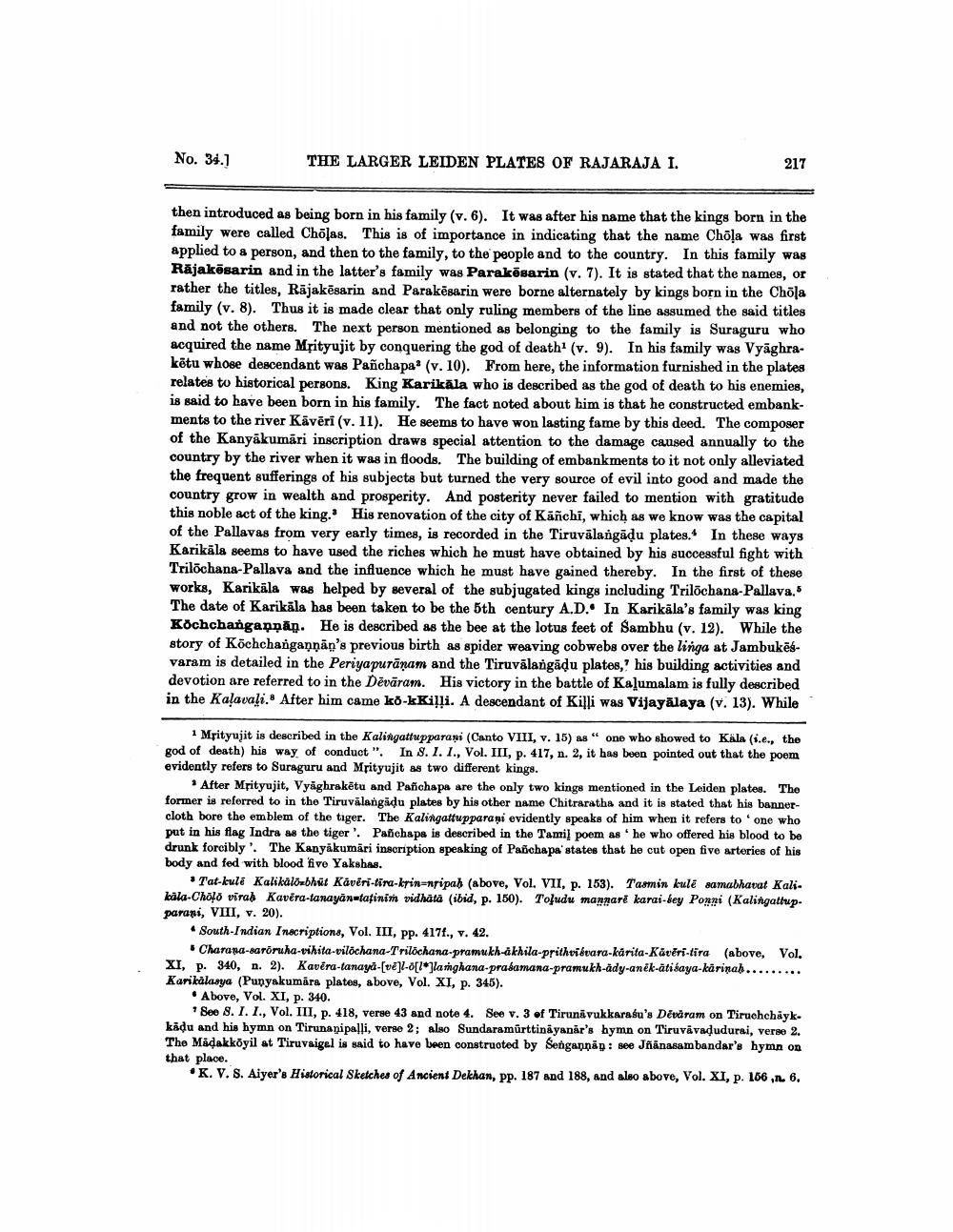________________
No. 34.]
THE LARGER LEIDEN PLATES OF RAJARAJA I.
217
then introduced as being born in his family (v. 6). It was after his name that the kings born in the family were called Chōlas. This is of importance in indicating that the name Chōla was first applied to a person, and then to the family, to the people and to the country. In this family was Rajakesarin and in the latter's family was Parakesarin (v. 7). It is stated that the names, or rather the titles, Rajakesarin and Parakesarin were borne alternately by kings born in the Chōla family (v. 8). Thus it is made clear that only ruling members of the line assumed the said titles and not the others. The next person mentioned as belonging to the family is Suraguru who acquired the name Mrityujit by conquering the god of death1 (v. 9). In his family was Vyaghrakētu whose descendant was Pañchapa (v. 10). From here, the information furnished in the plates relates to historical persons. King Karikala who is described as the god of death to his enemies, is said to have been born in his family. The fact noted about him is that he constructed embankments to the river Kävēri (v. 11). He seems to have won lasting fame by this deed. The composer of the Kanyakumari inscription draws special attention to the damage caused annually to the country by the river when it was in floods. The building of embankments to it not only alleviated the frequent sufferings of his subjects but turned the very source of evil into good and made the country grow in wealth and prosperity. And posterity never failed to mention with gratitude this noble act of the king. His renovation of the city of Kañchi, which as we know was the capital of the Pallavas from very early times, is recorded in the Tiruvalangaḍu plates. In these ways Karikala seems to have used the riches which he must have obtained by his successful fight with Trilochana-Pallava and the influence which he must have gained thereby. In the first of these works, Karikala was helped by several of the subjugated kings including Trilochana-Pallava.5 The date of Karikala has been taken to be the 5th century A.D. In Karikala's family was king Kochchanganṇan. He is described as the bee at the lotus feet of Sambhu (v. 12). While the story of Kochchangannan's previous birth as spider weaving cobwebs over the linga at Jambukēśvaram is detailed in the Periyapuranam and the Tiruvalangaḍu plates,? his building activities and devotion are referred to in the Deväāram. His victory in the battle of Kalumalam is fully described in the Kalavali. After him came kō-kKilli. A descendant of Killi was Vijayalaya (v. 13). While
1 Mrityujit is described in the Kalingattupparani (Canto VIII, v. 15) as " one who showed to Kala (i.e., the god of death) his way of conduct". In S. I. I., Vol. III, p. 417, n. 2, it has been pointed out that the poem evidently refers to Suraguru and Mrityujit as two different kings.
After Mrityujit, Vyaghrakētu and Pañchapa are the only two kings mentioned in the Leiden plates. The former is referred to in the Tiruvalangadu plates by his other name Chitraratha and it is stated that his bannercloth bore the emblem of the tiger. The Kalingattupparani evidently speaks of him when it refers to 'one who put in his flag Indra as the tiger'. Pañchapa is described in the Tamil poem as he who offered his blood to be drunk forcibly. The Kanyakumari inscription speaking of Pañchapa' states that he cut open five arteries of his body and fed with blood five Yakshas.
Tat-kule Kalikälö-bhút Kāvēri-tira-krin-nripah (above, Vol. VII, p. 153). Tasmin kule samabhavat Kalikala-Chölö virah Kavera-tanayan-taținim vidhätä (ibid, p. 150). Toludu mannarë karai-bey Ponni (Kalingattup. parani, VIII, v. 20).
South-Indian Inscriptions, Vol. III, pp. 417f., v. 42.
Charana-sarōruha-vihita-vilochana-Trilochana-pramukh-äkhila-prithviévara-kārita-Kāvēri-tira (above, Vol. XI, p. 340, n. 2). Kavera-tanaya-[vel-o[1]lamghana-prašamana-pramukh-ady-anēk-āti saya-kärinab..... Karikalasya (Punyakumara plates, above, Vol. XI, p. 345).
Above, Vol. XI, p. 340.
"See S. I. I., Vol. III, p. 418, verse 43 and note 4. See v. 3 of Tirunavukkarasu's Devaram on Tiruchchaykkādu and his hymn on Tirunanipalli, verse 2; also Sundaramurttinäyanar's hymn on Tiruvavaḍudurai, verse 2. The Madakköyil at Tiruvaigel is said to have been constructed by Sengannan: see Jäänasambandar's hymn on that place.
K. V. S. Aiyer's Historical Sketches of Ancient Dekhan, pp. 187 and 188, and also above, Vol. XI, p. 166, n. 6.




